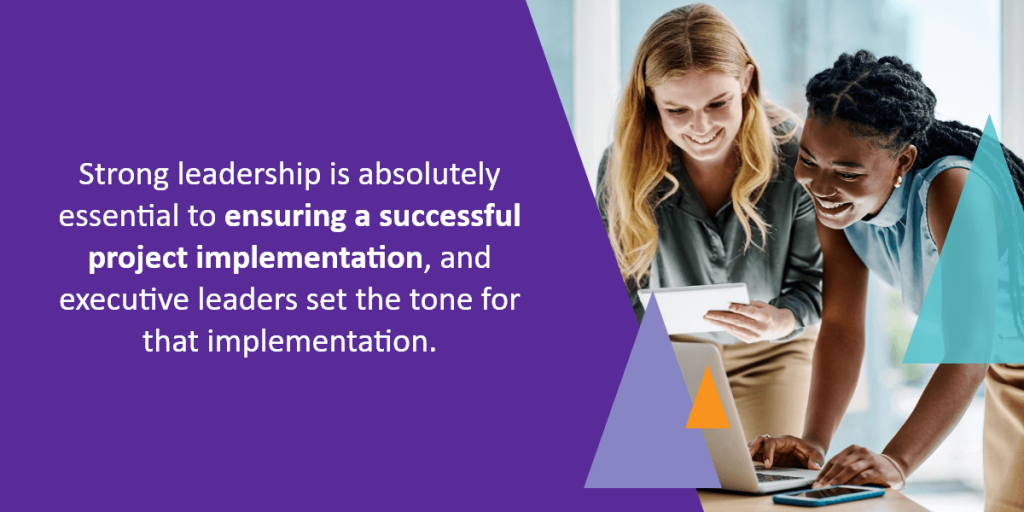
One of the key factors in creating a long-lasting improvement on your campus is learning how to understand your data and improve processes. The right technology can make these improvements much easier and uncover key insights to aid your continuous improvement efforts — but only if the technology is implemented correctly. Read on to learn how to make your technology implementation successful.
Readiness assessment
Higher ed technology often relies on the context in which it is placed. If data has been obscured or isn’t robust enough, the technology is likely to produce results that are inaccurate. To avoid this fate, leadership must commit to seeing the project through to the end.
Leadership
Strong leadership is essential for successful tech implementation. An institution’s president and executive leadership team first and foremost need to have a deep understanding and appreciation for the role that a technology initiative has within the institution. This helps to create space for the prioritization of the work that it takes to secure a successful outcome.
Executive leadership seeking to successfully implement new educational technology should consider the following:
- Do you have a willingness to evaluate internal processes to better serve faculty, staff, students, and the institution?
- Do you promote a common mission and values that unite your faculty and staff?
- Can you use that mission to unite faculty and staff when implementing this new technology?
- Do you have executive support for investment in this product and any subsequent training?
- Can you provide clear job expectations for everyone involved in implementation?
- Can you facilitate change management processes with clear, repeated messaging?
Responsibility for a successful technology implementation does not, however, stop with the executive leadership team. Mid-level leaders are called upon to sustainably and continuously move implementation efforts forward. Successful technology implementation projects can often involve a year or more of intensive, focused work, followed by ongoing sustainability efforts and continuous improvement. This process heavily relies upon mid-level leaders to work in close collaboration with implementation teams to serve as the product procurement team.
Here are the qualities to look for as a mid-level leadership team to ensure successful implementation:
- Individuals show a commitment to the value of the tool.
- Individuals show a willingness and ability to work through the implementation phases.
- Individuals can clearly articulate goals, including what outcomes are sought.
- Individuals are equipped to use data effectively to build understanding and trust with frontline faculty and staff implicated in implementation.
- Individuals can build high-functioning relationships with senior leaders and to provide cover to those deeper in the institution by serving as a buffer and translator between senior leaders and frontline faculty and staff implicated in use of the tool.
- The institution/implementation team has clearly identified stakeholders and knows how to translate across groups to build shared understanding and support for quality implementation (For example: Who are your champions? Where are the collaborative relationships to drive the adoption of your new tool?).

Institutional culture
While educational technology can be essential to your continuous improvement efforts, ultimately it is the people — not the technology — who create change. As such, the culture of an institution has a huge impact on the quality of the technology implementation and how it is used to drive institutional improvement.
In order to foster a culture that embraces data and cross-departmental collaboration, higher ed institutions need to cultivate the following:
- A dedication to continuous improvement, as evidenced by regular, routine courageous conversations about the data in order to identify what is effective for improvement efforts and what processes need fine-tuning.
- Multiple opportunities for professional development and training around how to access, understand, and leverage data (For example: How to use data in operations; how to read data and what it means; orientation to what the software looks like, etc.).
- Established processes and bandwidth to collect and analyze data so all staff have insights that support their roles and responsibilities.
- A commitment from executive leadership, implementation teams, and other departmental stakeholders to communicate frequently, early, and often across implementation stages.

Technology and data ecosystem
Before implementing a new technology program, higher ed institutions need to take the time to identify and clean up any issues in their current technology. Duplicate records, incomplete or outdated data, and inaccurate parsing of record fields from disparate systems can all slow or stall a successful implementation. Stacking new technologies onto old ones without assessing the readiness and completeness of the data can easily derail the implementation process.
Typically, IT departments are best suited to help identify any issues within the current technology and data ecosystem.
When assessing the health of a technology and data ecosystem, colleges and universities should consider the following:
- Do we have clearly defined and broadly accepted data definitions that span departmental units and are used consistently in our existing core systems of record?
- Given our prioritized product capabilities, what kind of data will need to be pulled into the product to allow for it to display accurate and actionable information?
- Where is critical student, academic, and other relevant data currently stored (e.g., SIS, pen and paper, Microsoft Excel)? To what extent can the new product integrate with these core systems, and what workarounds may be needed if full interoperability is not possible, which is often the case?
- Given our stakeholder needs, how frequently will different information displayed in the product need to be updated to maintain the integrity of the product? (Note that while access to real-time data is ideal, it is not always possible for all data points.)
Once you take all of the above considerations into account and address any issues, you may feel ready to move forward with the implementation process. The first step in the implementation process is deciding what product is best suited to meet the needs of your institution. Consider some of the most important product requirements by talking with faculty and staff that will be implicated in this change.
Administrators
Since institutions need to ensure that they have both the proper data and the capability to take a high-level snapshot and draw accurate conclusions from that data, administrators often seek to have user-friendly dashboards.
Administrators and leadership teams often seek technologies that have:
- The ability for the system to pull from multiple data sources and core technology systems (SIS, LMS, etc.).
- The ability to define and track specific KPIs that leadership needs to evaluate initiative success.
- A user-friendly interface that is easy to navigate for non-technical staff.
- The ability to display data graphically through engaging data visualization tools.
- The ability to see data trends at a high level as well as data on an individual student level.
- The ability for multiple users across departments to access the data dashboard so that it can be used broadly to improve student success.
When all impacted parties across a college or university are engaged with the implementation process, collaboration and data collection become more streamlined. The efforts to successfully implement a new technology program from the get-go can help to ensure that your institution successfully adopts the new software solution, leading to better data and more robust insights.














































































































































































































































































































































































































